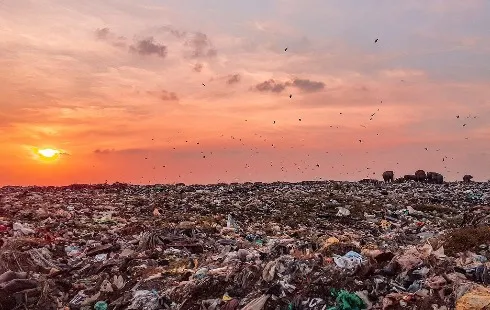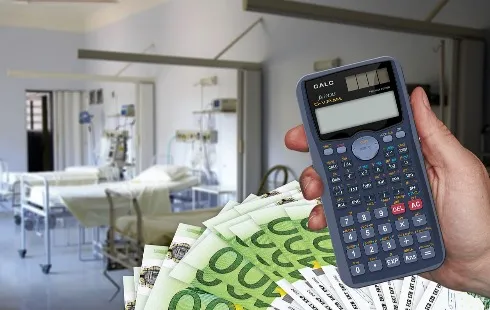
Pantone's Color of the Year an Endless Neutral Loop
Section: Fashion
You are what you wear. A phrase, containing in itself more than a combination of yellow skirt, pattern t-shirt and funky shoes. It raises awareness in consumer decisions and their long term impact on the environment of our planet. And since the fashion industry is one of the most environment-damaging in the world, let's have a closer look at what exactly we have in our wardrobes, how healthy and eco-friendly it is and can we turn the scary pollution statistics into beauty and esthetics.
My first real interaction with accessories made of recycled materials was around Christmas last year, when I met the young fashion designer Jara Altamirano in Munich. She had the ambition to spread the Love with eco-friendly accessories, made of recycled materials, and thus turn the world into a better place. Since this day, I don't miss a compliment every time I wear my statement necklace, made of an old leather purse.
It all started in the early 90s when the concept of recycling and environmentally-friendly materials began to develop and raised questions on how to creatively be more conscious of our environment. The mavericks of the Eco style were the Belgian designer Martin Margiela, reconstructing his bits and pieces into evergreen and the iconic Giorgio Armani, experimenting and introducing hemp to his lines. The more years were passing by, the more names were added to the Green fashion list - Stella McCartney added value to the eco fashion label with her no-leather-no-fur agenda. Comme des Garcons and Calvin Klein joined later on, and Bono and his wife Ali Hewson founded the label Edun in 2005 to raise a voice for eco-oriented production. In 2007 there were already ethical labels spread all over the world - Noir in Copenhagen, Barneys Green Label in New York and Keira Knightley herself by wearing "I am not a plastic bag" slogan on her Hindmarch shopper. Diane von Furstenberg and John Patrick contributed to "Future Fashion White Papers", a book of essays on sustainability in the industry. As a fast developing movement, Eco fashion has already created its own stage by hosting numerous events around the world like Eco Fashion days in Berlin, Eco fashion week and the Green Shows held in NYC.
Statistic-wise, fashion might look scary. From the consumer point of view, an average American household spends annually 1,700 USD on apparel and footwear. In Manhattan, the average monthly spending on clothing exceeds 300 USD. To maintain such a dynamic, the production houses get quite busy, especially in the outsourced markets like China. As an example, every year millions of tons of unused fabrics at Chinese mills go to waste when dyed with the wrong color, and in 2012 more than 6,000 factories were found to be violating environmental regulations, working with brands like Nike, Walmart, H&M Levi's, and Burberry. They all have now started to take proactive measures, pushing suppliers to take corrective actions.
What is the future of essential fashion from recycled materials and does it mean we have to be hippies to appreciate this counter movement? I found the answer in Love by Eco. The label was born by combining art with fashion, using only post-consumer materials to create sustainable fashion. And sustainable fashion doesn't mean a trend, because trends change. It means a movement that encourages a more creative and conscious way of considering fashion nowadays. It's not just a label! The accessories made of used materials like old leather bags, furniture covers or tin cans are usually one of kind unique pieces with a lot of history in them. They could be a real challenge for the current fashion market to adapt to this concept. However, Jara is very optimistic about the future of eco fashion, believing that it will grow, due to the importance of the cost involved in mass production - financial, human and environmental. There's a growing niche of consumers who are realizing the importance of that problem and are supporting small designers who are coming up with sustainable fashion products and ideas that promote green living. Those are the specific type of consumers who would prefer to state a handmade alternative accessory rather than wear a commercial product. The problem also touches some psychological borders - do we really consume everything we buy and what do we do with all this waste? Moreover - why do we need to buy those large amounts of cheap clothes and accessories and throw them away after few wears?
Sustainable fashion aims to change the perception of consuming. The old purse could be completely transformed into a beautiful necklace or a bracelet and brought back to the daily catwalk. The seeds from South America look unique and colorful in long necklaces and their creation doesn't require the usage of any chemicals or processing that, at the end, could be damaging not only for the jewelry artists and the environment, but also for those who wear them.
Jara's favorite material is fabric. She also uses post-consumer materials - plastic bags, seeds, fruit peels, soda cans from everyday items that would otherwise be thrown away. Each Love by Eco design is uniquely handmade with upcycled materials mixed with tons of creativity, art, care and love. Jara is originally from Mexico, but had the chance to live in USA, Canada, Germany and Japan. She's a RAW community artist and presented her work at the latest RAW fashion show in California this year. Nonetheless, her favorite eco fashion place is Munich where she already held a few successful exhibitions of jewelry made of recycled materials. She creates each design individually to enhance any outfit and make women look unique and elegant. Wearing jewelry from recycled materials is a way to make a difference not only for the environment; it also brings uniqueness to the personal style with a statement of inspiration, to make the world a better place. And that was exactly the eco style advice which Jara gave to all of us, the readers of The Munich Eye.

Section: Fashion

Section: News

Section: Fashion

Section: Arts

Section: Politics

Section: Health Insurance

Section: News

Section: News

Section: News

Section: Arts
Both private Health Insurance in Germany and public insurance, is often complicated to navigate, not to mention expensive. As an expat, you are required to navigate this landscape within weeks of arriving, so check our FAQ on PKV. For our guide on resources and access to agents who can give you a competitive quote, try our PKV Cost comparison tool.
Germany is famous for its medical expertise and extensive number of hospitals and clinics. See this comprehensive directory of hospitals and clinics across the country, complete with links to their websites, addresses, contact info, and specializations/services.
Join us for an enchanting Christmas adventure at the Münchner Marionettentheater! Experience the marionette play 'Der verschwundene Wunschzettel' by Siegfried Böhmke, featuring our beloved Kasperl Larifari and his little friend Stupsi. As Christmas approaches, both Kasperl and Stupsi have prepared...



No comments yet. Be the first to comment!